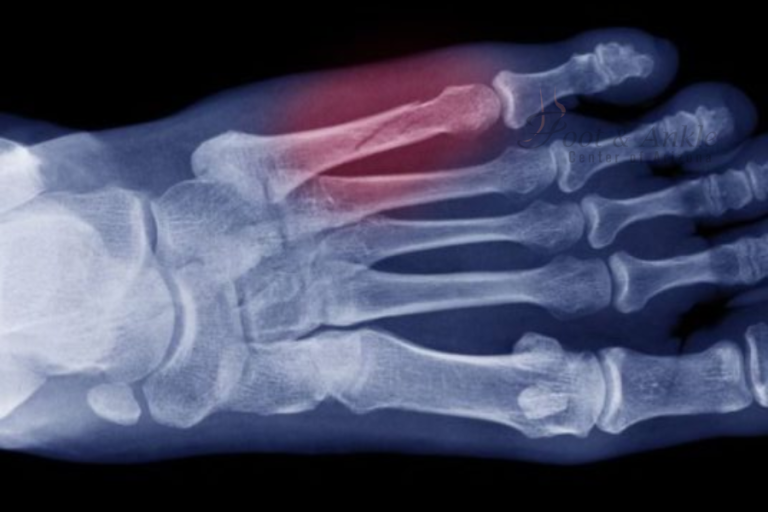A bunionectomy is planned surgery to treat a bunion—a bony bump that develops on the joint at the base of your big toe. Mostly painful, it can cause one problem or another in walking. If you are looking to undergo a bunionectomy or maybe have just had one, you wonder, “How long after a bunionectomy can you walk?” This detailed guide answers that and will give you information about the recovery process in its entirety.
Understanding Bunionectomy
A bunionectomy is the removal of a bunion through a surgical procedure. Various types of surgeries can be carried out to treat a bunion. These include:
Chevron Bunionectomy: This involves making a V-shaped cut in the bone to realign it. This type of surgery is very common and effective.
Double Osteotomy Bunionectomy: This is a technique where two different cuts in the bone have to be made. This kind is mostly used for bigger bunions.
Regardless of the type, the goals of surgery are pain alleviation, deformity correction, and functional improvement in the foot.
Early Recovery Period
immediately following your surgery, your foot will be dressed with the probable wearing of a splint or surgical shoe to protect the foot and facilitate healing. Here’s what to expect within the first few weeks:
First 24-48 Hours: Your foot must be elevated, and ice must be applied to the area to reduce swelling. Pain and discomfort are generally felt, and you will most likely get some pain medications prescribed.
First Week: You should move around as little as possible. The elevation of your foot is recommended most of the time, and do not bear weight on it. Crutches or walkers could very well be needed.
Walking After Bunionectomy
How soon one can walk after a bunionectomy depends on many variables that may include the extent and type of surgery, overall health, and adherence to post-operative directions. Here is a general timeline to help keep expectations in a realistic range:
Weeks 2-4: You might be allowed to put some weight on your foot in a protective boot or surgical shoe. Walking should be minimized and very cautious.
4-6 weeks: Many patients, by this period, can walk more comfortably in supportive shoes. The doctor might give an option for undergoing physical therapy to regain strength and flexibility.
6-8 weeks: By this period, most of the patients are usually able to walk without much discomfort. Patients can now resume with regular shoes, but they should be loose and a little supportive.
3-6 Months: Your complete recovery might take several months. Within this period, you can usually resume most of your regular activities except for high-impact ones until your doctor finally gives a nod.
Tips for Seamless Recovery
Follow Instructions by Your Surgeon: This cannot be emphasized enough times. The post-operative care guidelines handed over to you by your surgeons are of immense significance about prescribed medication taken at given timelines, following up with appointments, and observing the restrictions put on weight bearing.
Keep the Surgical Area Clean: Good hygiene will help in the prevention of infection. Follow the doctor’s instructions regarding incision site care.
Physical Therapy: Work on suggested physical therapy exercises that improve recovery and mobility.
Shoe wear: Wear shoes that are roomy and supportive—no pressure on the healing area.
Monitor for Complications: Monitor for the following signs that indicate complications such as excessive swelling, severe pain, or signs and symptoms of infection such as redness, warmth, and discharge. Contact your doctor if you notice any of these symptoms.
Common Concerns and FAQs
1. Will I have a scar after bunionectomy?
Yes, scarring from bunionectomy is an anticipated part of the healing process. The size and prominence of the scar often vary with surgical technique and the biological tendency for scarring. Over time, the scar normally fades away and becomes less conspicuous.
2. How would I know the best surgeons for bunions near me?
Here are guidelines for how to find the best surgeons for bunions near you:
Research: Board-certified podiatric physicians specializing in foot surgery, and board-certified Podiatrist surgeons with specialty training and practice in foot surgery. Reviews/Referrals: Patient reviews and referrals from his physician, family, and friends. Consultations: Schedule consultations with hopeful surgeons who could do the surgery and discuss the case both to hear how the surgeon approaches the problem and to understand the surgeon’s knowledge.
3. What is Bunionplasty?
Bunionplasty is an esthetic surgical procedure that aims at correcting bunions with minimal scarring and better esthetic outcomes. If you are searching for Bunionplasty near me, make sure the surgeon is experienced and has good reviews in performing this particular procedure.
4. How do I find bunion surgery near me?
Finding bunion surgery near you:
Online Searches: You can search on the internet regarding clinics and surgeons who provide bunion surgery in your area.
Local Directories: Check under local medical directories and hospital websites.
Consultation: For getting professional advice and highly personalized care, visit the Foot and Ankle Center of Arizona.
Recovery from Bunionectomy: What to Expect
The recovery process associated with bunionectomy surgery is gradually done. Knowing what to expect can make one better prepared and also manage one’s recovery efficiently.
Pain Management: It is expected to experience some discomfort soon after the surgical procedure. It is readily controlled by medications and rest. Follow your doctor’s suggestions of pain management techniques.
Swelling: Swelling may last several months. Elevating your foot and applying ice can reduce swelling.
Activity Level: Initially, keep your activity level low and only increase as tolerated by your physician. Avoid running, jumping, or any high-impact exercises until completely healed.
Shoes: Wear comfortable, supportive shoes. Also, it is better to avoid shoes that are too tight or too high-heeled during the recovery period.
Chevron Bunionectomy in Scottsdale
If anyone is looking to have a Chevron Bunionectomy performed in Scottsdale, then the Foot and Ankle Center of Arizona can offer the most specialized care regarding performing this kind of procedure. Our surgically trained physicians make sure you get excellent results with minimum discomfort.
Conclusion
The key to complete recovery from a bunionectomy lies in proper understanding regarding the timeline for walking and what to expect in general. You can do just that by simply following through with what the surgeon prescribes, working on your physical therapy, and remaining mindful of carefully made decisions about your lifestyle to regain mobility and enjoy life without pain.
Whether patients are seeking the best surgeons for bunions in your area, Bunionplasty options, or specific procedures like Chevron Bunionectomy in Scottsdale, the Foot and Ankle Center of Arizona is here to provide top care and support throughout your journey to recovery.





